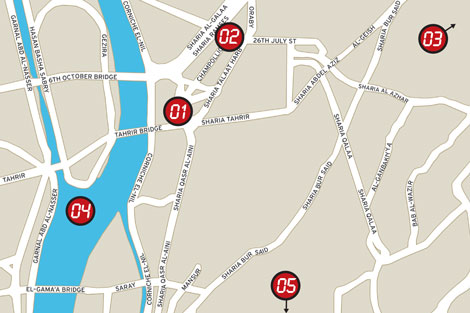
1. Egyptian museum
Cairo is a busy, noisy place, and at first it can seem everyone wants a piece of you. Don’t be put off. Start with the must-see sights where there’s a level of protection from the constant importuning, and head for the Egyptian Museum. Despite being badly lit, poorly financed and organised in an idiosyncratic way, it’s one of the greatest museums in the world. The crowds (rightly) head for the Tutankhamun collection, which is always breathtaking, even if some of the pieces are often on loan to museums around the world. There are two floors of artefacts, and even if you have little knowledge of antiquities, this is a place where you can really begin to appreciate the sophistication of this ancient civilisation and the creepy grandeur of its beliefs. There are also chatty printed labels next to many of the exhibits. Entry is E£20 (£2), plus E£40 to see the Mummies Rooms. Visit egyptianmuseum.gov.eg.
2. Downtown cairo
From the museum you can walk to the centre of Downtown, probably the most easily negotiated of Cairo’s districts for the first-time visitor because, like so many European capitals, it was based on the new Paris boulevards designed by Georges-Eugène Haussmann, and has very similar architecture. There are few specific sights – this is more a place to absorb the atmosphere and build up confidence in saying “no” to the salesmen. (The Cairo section of The Rough Guide to Egypt has some good suggestions for shops and cafés.)
3. Khan el-Khalili
Now you are ready. The souks of Khan el-Khalili have been here since the Middle Ages and give a real flavour of Islamic Cairo, not only because of the several mosques (Al-Azhar, Saiyidna Hussein and Muhammad Bey Abu al-Dhahab) but also the bazaar itself, where traders will try and sell you everything from tourist rip-offs (at considerably lower prices than you’ll find elsewhere) to meat, fish, nuts, spices and jewellery.
Strangely enough, the chances are it will be the T-shirt floggers who are the most persistent, although away from the main drag of Muski (which grows more pot-hole strewn the further you walk north-west), you can explore the areas dedicated to goldsmiths and coppersmiths, and the perfume bazaar. Take time to stop at one of the cafés, and if you’ve read the 1988 Nobel Prize winner for literature Naguib Mahfouz, there’s even the Midaq Alley where his bestselling book (of the same name) was set, and where you can steal a moment’s peace from all the hassle.
4. Nile cruise
While a leisurely three or four-day crawl down the Nile to Aswan, stopping only to solve an onboard murder à la Agatha Christie, is out of the question, there are other options. You can take a walk along a stretch of the river, book into a hotel which overlooks it (such as the famous Nile Hilton, soon to be rebranded a Ritz-Carlton) or, if you have time one evening, go on a cruise such as the one offered from outside the Grand Hyatt Cairo hotel (cairo.grand.hyatt.com). The Nile was worshipped by the ancients and even today its sweep out of the desert towards the sea is a natural wonder.
5. Pyramids of Giza
Further upstream, visiting the pyramids would take four hours alone, but if that’s all the time you have in Cairo, then this is the one thing you should do. If it seems sacrilege to try and do the pyramids in half a day, consider the alternative – going to Cairo and not seeing them, thinking you’ll come back some day, and then not having the chance.
Try and forget the incessant hounding from the guys on camels, the guides and the small children, and accept that you are one of 10,000 coach visitors arriving that day. The pyramids and the Sphinx won’t disappoint. Tourists have been coming here since before the time of Christ, and the pyramids were more than 2,000 years old then, and their origins more mysterious than they are today, thanks to the work of archaeologists and Egyptologists. From the coach park on the hill, you can see the suburbs of Cairo in the distance and, incredibly, a green swatch of tree-lined golf course just visible close to the Great Pyramid.








